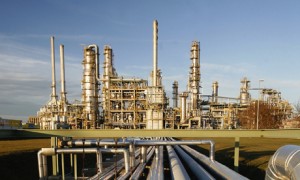 Both West Texas Intermediate and Brent crude benchmarks fell on Monday amid seceding geopolitical risk in Iraq after Kurdish Peshmerga fighters and Iraqi troops fully retook the Mosul dam from Islamic State militants, aided by joint air power. Rising tension in Ukraine, however, kept the market underpinned. Natural gas extended losses as weather forecasts called for mostly mild patterns across the US through the end of August.
Both West Texas Intermediate and Brent crude benchmarks fell on Monday amid seceding geopolitical risk in Iraq after Kurdish Peshmerga fighters and Iraqi troops fully retook the Mosul dam from Islamic State militants, aided by joint air power. Rising tension in Ukraine, however, kept the market underpinned. Natural gas extended losses as weather forecasts called for mostly mild patterns across the US through the end of August.
On the New York Mercantile Exchange, WTI crude for delivery in October lost 1.36% by 13:22 GMT to trade at $94.02 per barrel, having shifted in a daily range between $95.14 and $94.01 a barrel. The US crude benchmark added 1.3% on Friday to close the week about 0.3% lower, having reached an eight-month low of $93.85 a barrel.
Meanwhile on the ICE, Brent futures for delivery in the same month were down 1.65% to trade at $101.82 a barrel. Prices shifted in a daily range between $103.30 and $101.77 a barrel. Brent added 1.4% on Friday, trimming its weekly decline to 2%. The European crude benchmark traded at a premium of $7.80 to its US counterpart, after closing last week at a gap of $6.18.
Iraqi military spokesman Lt-Gen Qassim Atta told state TV that the Mosul dam – Iraqs largest, has been completely retaken from the Islamic State militants with the help of a joint air patrol. However, journalists reporting from the area said clashes were ongoing and jihadists were still in control of the main gate.
The fighting remains contained to Iraq’s northern regions, well away from the biggest oil-producing and exporting facilities, concentrated in the south. The country pumps around 3 million barrels of crude per day and exports about 2.5 million through its southern terminal at Basra, with outlooks of growing output and shipments.
“The situation in Iraq is something that markets will continue to have front of mind,” Ric Spooner, chief strategist at CMC Markets in Sydney, said for Bloomberg. “That said, the most likely outcome is Baghdad will hold and there won’t be incursions into the south, or events that will really disrupt oil supply.”
Meanwhile, output form Libya climbed to some 0.55 million barrels daily, a government spokesman said on Sunday. Libyan production is still a fraction of what it used to be before a revolution toppled former dictator Muammar Gaddafi. The country holds Africa’s largest crude reserves, and has a potential output of ~4 million barrels per day.
Ukraine
Oil prices however kept drawing support after the most recent escalation of tension in Ukraine led to the death of an unknown number of civilians. A convoy of civilians being escorted by the Ukranian military from the towns of Khryaschuvate and Novosvitlivka have been attacked by “terrorists” armed with guns from Russia, Ukrainian Col. Andriy Lysenko told CNN. Casualties included women and children.
The civilians were attempting to escape clashes between government forces and pro-Russian separatists but were not moving through an established humanitarian safety corridor when they came under fire in Ukraines Luhansk region.
Earlier, Ukraine reported it has destroyed a column of armored vehicles entering Ukraine from Russia, while another column of rocket launchers was also seen entering rebel-controlled territory from Russia.
The Kremlin has repeatedly denied supplying rebels with weaponry such as the Buk missile launcher, which is thought to have downed the Malaysian airliner in June, killing 298 civilians.
The reports of heavy weaponry entering Ukraine comes as a Russian aid convoy was also poised to enter Ukraine through a rebel-controlled border crossing. Kiev has explicitly said that it would allow such aid only if the convoy passes into Ukraine through a government-controlled crossing. Russian authorities had said the convoy carried only humanitarian supplies and it was agreed with both Kiev and the International Committee of the Red Cross, but both denied to have agreed.
Some western countries suspect the convoy of transporting military supplies to the separatists, and have demanded an international inspection of the cargo before it enters Ukraine.
The confrontation between the West and Russia over Ukraine brought forth the lowest point in relations since the Cold War. Several rounds of economic sanctions were imposed by both sides, as Russia accuses the West of trying to lure Ukraine away from the Kremlin.
Sanctions have so far failed to affect Russian energy exports, the biggest in the world. However, signs of increasing difficulties for Russian energy companies are seen, though disregarded by investors.
Natural gas
Meanwhile, natural gas erased its daily losses but remained pressured as weather forecasting agencies predicted cooler-than-seasonal weather across most of the US through the end of August, despite a minor warm-up in the central and northern US which is expected to take place this week.
On the New York Mercantile Exchange, natural gas futures for settlement in September rose by 0.40% to $3.791 per million British thermal units by 13:18 GMT. Prices fell to a three-week low of $3.727 earlier in the trading session, while day’s high stood at $3.793. The energy source lost 3.33% on Friday to close the week at $3.776, marking its first weekly decline since July. Prices have lost around 20% since mid-June.
According to NatGasWeather.com’s weather report for the August 18th – 22nd time span, many small weather systems will track across the US, bringing showers and thunderstorms, but they will be milder and allow temperatures in the northern US to gradually warm to the lowers 80s. The southern parts of the country will remain warm and will even heat up by several degrees. To the West, however, several weather systems with showers and thunderstorm will push readings down below the average, including the high-consuming state of California. Overall, despite the minor rise in temperatures in some parts of the US, the general trend will be neutral to slightly-colder, allowing for larger-than-average inventory builds. Cooling demand will be moderate compared to normal this week.
As for the time period between August 23rd and August 29th, NatGasWeather.com expects a new strong Canadian weather system to penetrate the ridge and bring rain, thunderstorms and below-seasonal readings to the Pacific Northwest and extend further south to the central US late this weekend. This would be considered a slightly bearish trend as cooling demand would again drop to lower than usual over many highly populated states for at least 2-4 days once the cold front passes through. The system also bears a chance to touch the southern states and lower readings to the upper 80s across the Southern Plains and Southeast instead of the seasonal 90s. As the weather system dissipates, a following warm-up is expected, but it would have already ensured another much larger-than-average weekly build in US inventories, due to be reported on August 28th.
Brian Bradshaw, a portfolio manager who oversees energy-derivatives trading at $1 billion fund firm BP Capital in Dallas, said for the Wall Street Journal: “We think you’re going to have plenty of gas for the winter unless you’ve got some kind of extreme weather event, which, how likely is that?. You have to say it’s a low probability.”





